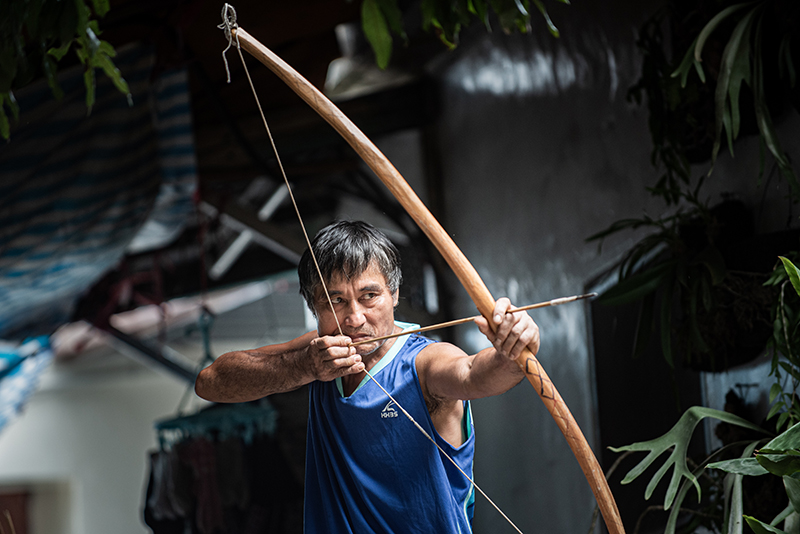Above: Chung arranges his boar's dentary in a neat row in the storage room.

Chung De-Rong began making bows and arrows with his grandfather after his discharge from the military service. Slowly, he shares the steps of bow and arrow making with every detail tied to the wisdom of his ancestors. In this age, when fewer and fewer indigenous persons know how to make bow and arrow, his skill is even more precious.
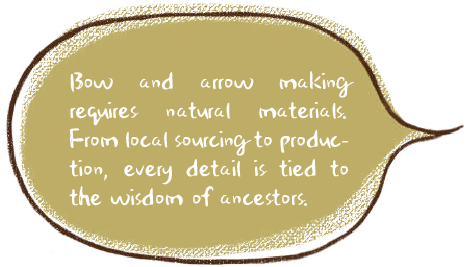

Dowmung Community in Hualien is one of the few indigenous villages in Taiwan which still has the skill to forge cutting tools. Entering a storage room inside this indigenous community, an entire row of boar dentary hang on the wall, and antlers stacked in boxes on the ground. Proof of hunter Chung De-Rong’s spectacular skills. On the day of this interview, he has just come back from hunting in the mountains.
61 this year, Chung grew up a restless child, and took up hunting with his grandfather when he was just a first-grader. “Hunting is our life. There didn’t used to be so much food, and working in the mountains, we could make a meal out of one rat.”
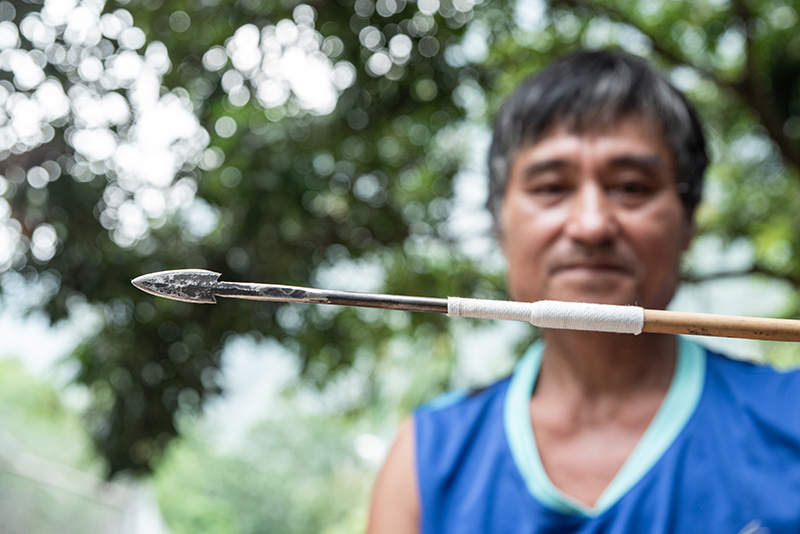
Make Your Own Hunting Tools
Chung’s grandfather taught by action instead of preach, and showed him how to set traps, make bow and arrow, and differentiate animal trails. Little by little, he learned by heart and came into a hunter of his own before he turned 20. “I saw many boars in the mountains. Grandfather knew that I already know how to set traps, so he sent me hunting alone. It was a little frightening walking in the mountains alone at first, but you get used to it,” shares Chung.
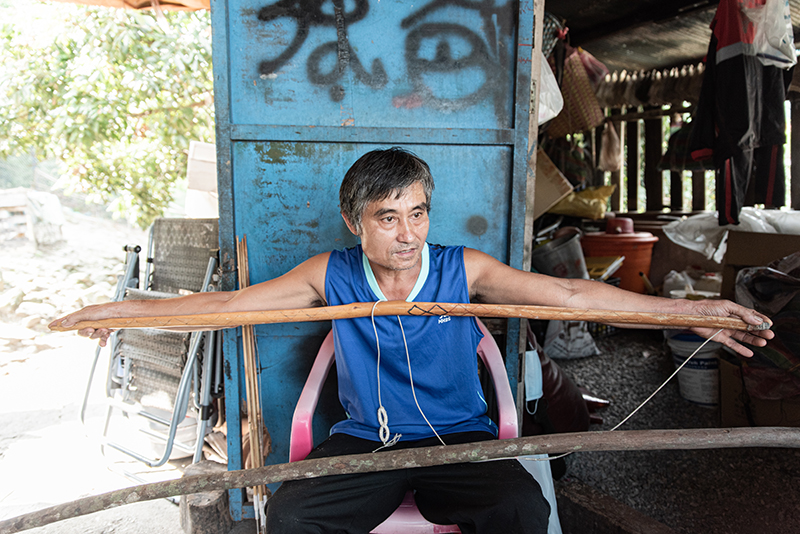
The length of a bow is roughly the length of arms opened wide.
Recalling the sense of accomplishment the first time he caught a boar as if it were yesterday, “boars are really smart, the smartest of all animals. You must be able to catch boars to be considered a real man in this indigenous community!” Having mastered the skill and recognized as the Boar Killer, he has captured over 4,000 boars over the decades, sometimes up to 7 or 8 boars per week. His best record is trapping a boar weighing over 150 kilos with a fat layer up to 3 fingers thick, “if I kept all the boar dentary in the storage room, I would’ve long ran out of room!” Chung laughed heartily.
Chung makes his own hunting equipment and traps, “you must make your own tools.” He shares the many taboos elders mentioned when making traps. For example, children and women must not pass in front of the trap or step over it, else it will bring bad omen.
A Good Bow
is All About the Grip
There were no shotguns in the past, bow and arrow were a hunter’s best friend in hunting. Chung began learning bow and arrow making with his grandfather after he was discharged from the military service. Picking up a bow he personally made from scratch, he says, “bow and arrow making require natural materials. From local sourcing to production, every detail is tied to the wisdom of our ancestors.”
The simple sleek look requires great attention to details, the sourcing and processing of materials alone will take great effort. A traditional bow is made from wood, mostly using Pruxul, which is both firm and flexible, and on some occasions the wood of Common Jasmine Orange. Chung points out that when collecting wood, one must look for those that are perfectly straight and cure the wood over heat once collected, “wet wood tends to be softer and breaks easily.”
Curing time depends on the thickness of the wood and the weather, generally taking one to two weeks to cure. Therefore, the best season to collect wood is winter, not only can dry wood be easily found, curing time can also be shortened. Since natural material is used, a finished bow can still be affected by the weather and change accordingly, Chung shares, “if you hunt on a rainy day, the bow will soften from absorbing moisture. You must wipe it down and dry it over heat immediately upon your return, so as to resume the strength of the bow.”
Bow making requires cutting the wood to a suitable length around 160 cm, Chung explains, “roughly the length of your arms when you open wide.” Then skin the wood with the knife, slowly trimming the thickness and curvature of the bow until it can bend slightly, but making sure it’s not too thin so that it will not fracture easily. “Another detail to note is that the grip is the center point, the curvature of the wood above and below the grip must be exactly the same so that force can be evenly applied, or else the arrow will not shoot straight,” Chung reminds us.
The bow making steps can be explained one by one, but the slicing and trimming process is all about the experience. Skillfully wielding his knife, Chung comes up with the rough shape of a bow in no time. “Bow making is all about the grip, it must be a comfortable and easy grip.” After Chung finishes with the details of the bow, he will attach a small piece of goat horn to the ends of the bow to add strength, so the bow will not easily wear out when standing on the ground.
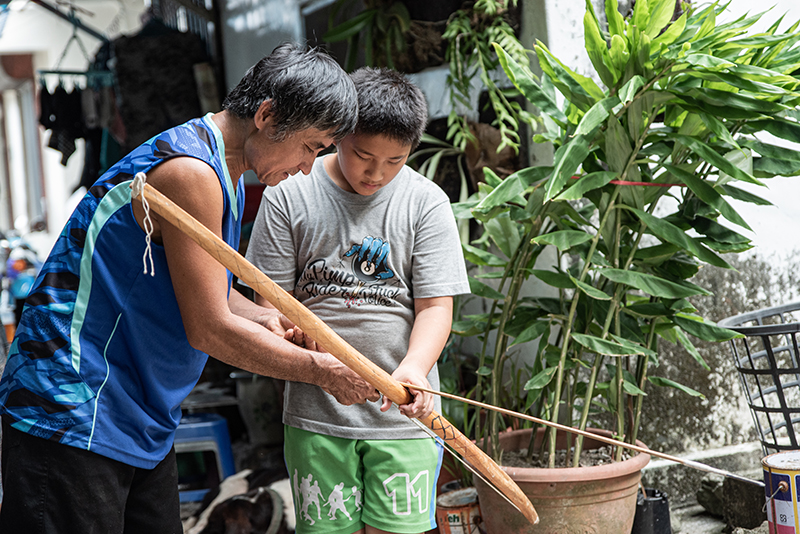
Chung teaches children how to hold a bow.
From Arrow to Arrowhead,
Detail Makes the Master
Unlike the bow, the arrow is mostly made from mountain Arrow Bamboo, the knots are smaller and the shape straighter. When souring the bamboo, the older the better and less easily fractured. The bamboo must also be dried over heat, wet bamboo breaks easily and is heavier. An arrow is roughly 80 cm long, and can be adjusted according to the length of the bow. Once the length is cut, Chung stacks the bamboo pieces over the fire to shape over heat, and adjust the bamboo so that it becomes perfectly straight. That basically completes the arrow.
The arrowhead is mostly forged out of scrap metal found in everyday life, such as the discard chassis of a car, heated and hammered to shape a sharp edge. Chung shares a simple method to determine whether the arrowhead is sharp enough, “if you can shave with it, it is sharp enough, an arrowhead like that can pierce right through a monkey.”
Once the arrow and arrowhead is ready, it is time to combine them. Traditionally they used ramie planted by the indigenous community to spin thread, and wrapped tightly and repeatedly around the arrow and arrowhead before finishing with a layer of glue on the outside, increasing firmness. Quick glue wasn’t available in the old days, ancestors would apply the sticky cedar sap over the tightly bound ramie thread to prevent the pieces from falling apart. Finally, the skin of goat or Formosan Muntjac is used to make the quiver, holding the arrows together. If all materials are in place and readily prepared, a set of bow and arrows can be made in one day.


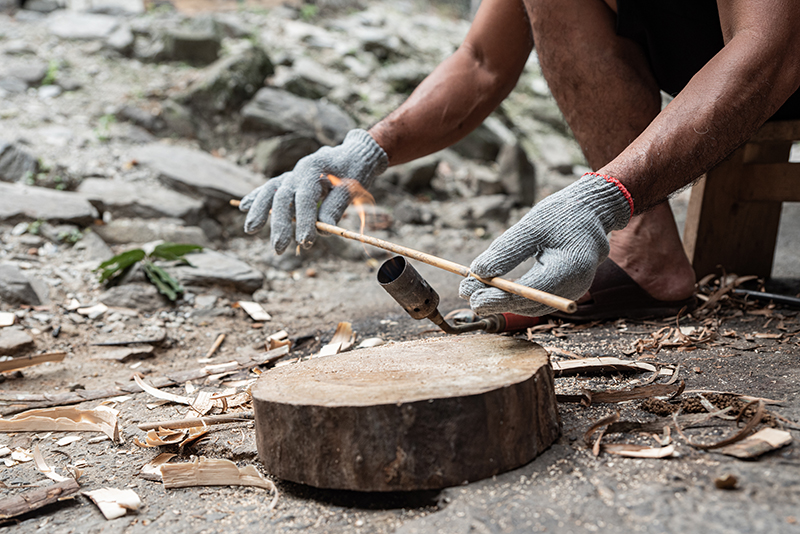
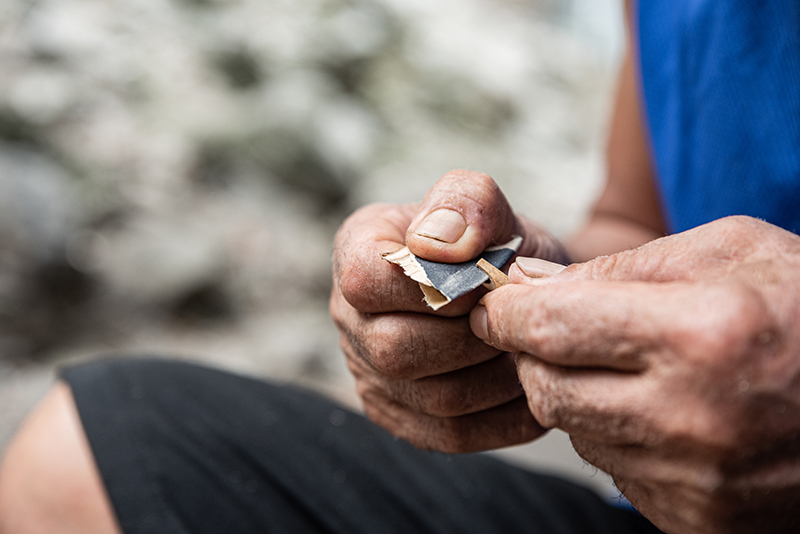
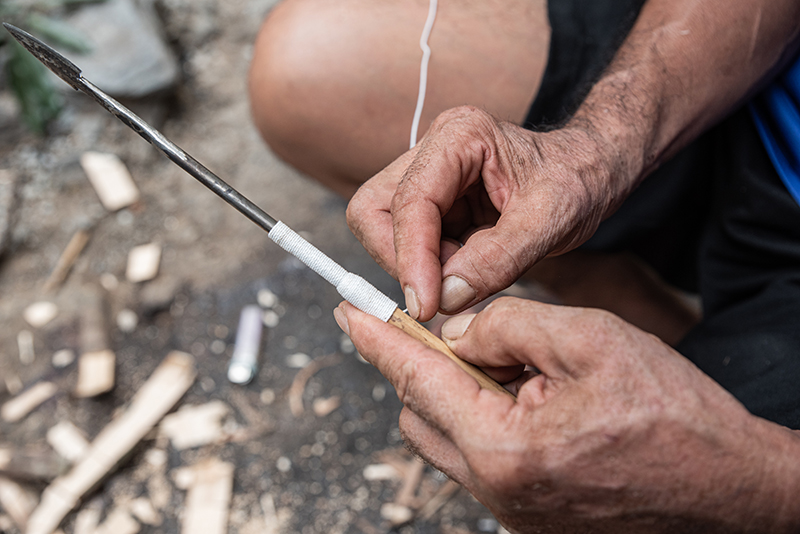
Every detail in bow making shows Chung’s masterful skill.
Shotgun Renders
Bow and Arrow Useless
Chung used to practice shooting arrows by placing small cans in the distance, only when he could shoot bulls eye three times in a row did he grandfather acknowledged his skill. Due to the densely grown branches in the mountains, the angle of the bow needs to be adjusted when shooting, “if you hold it perpendicular to the body, the bow or the shot arrow could easily get stuck in the branches and vines,” Chung explains.
Having hunted at least 200 boars with bow and arrow, Chung believes that even with a shotgun available now, he sees no different between the two, they are both hunting tools. But the bow and arrow win in the lack of sound. “Other animals run away at the BANG of a shotgun,” he laughs and then says, “but when the arrow is shot too far, it can be difficult to retrieve.”
The shotgun has gradually rendered the bow and arrow useless, with fewer and fewer people still know how to make the bow and arrow, and even Chung only uses the bow on rare occasions. A bow like this is not only tool for finding food in the mountains, but the accumulation of traditional culture in the indigenous community. How to properly and completely pass on this craft is a challenge to the entire society.
